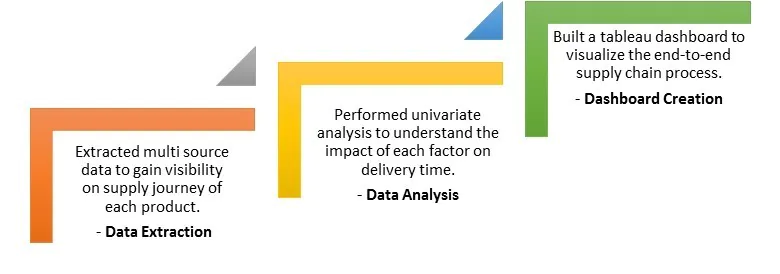Table of Contents
What You’ll Find in this Case Study:
- Pharma Supply Chain Analytics Solutions for the Industry
- Pharma Supply Chain Analytics Challenges Faced by the Client
- Revolutionary Pharma Supply Chain Analytics Solutions for the Client
- Key-Takeaways
Pharma Supply Chain Analytics Solutions for the Industry
Before taking a deep dive into our case study, let’s first understand the role of pharma supply chain analytics for the healthcare industry. Pharmaceutical companies face intense competition from both domestic and global players and are under tremendous pressure to revamp their supply chains and operations efficiency. Outdated IT systems and infrastructure cause a lack of visibility into inventory and distribution processes. Also, due to a fragmented sourcing process, the overhead costs for inventory are higher than expected. The expired patent protection on products has led to excessive inventory, and the industry is looking for every possible opportunity to improve the efficiency of its supply chain system.
Government involvement and FDA approvals in the healthcare industry have changed the dynamics of the pharma industry. The pharma executives have realized the need to optimize their supply chain functions and enable them to manage market pressure. Quantzig’s supply chain analytics engagement enables inbound supply chain visibility for cost reduction, inventory optimization, and improved supply chain planning. The study also offers insights on cost optimization, efficient inventory and distribution management, and better supply chain visibility.
The current healthcare industry is witnessing the shift to a more value-based approach to eradicate life-threatening diseases and improve the quality of healthcare services being offered. Also with the rising political uncertainties and sluggish economic outlook, businesses in the medical devices space are becoming concerned about promising better healthcare services to meet the unique market requirements. In the medical devices space, companies are focusing on reducing healthcare expenditure and dealing with the increasing market competition to create the value proposition for the customers. Furthermore, to improve healthcare outcomes, businesses are facing the need for supply and demand forecasting as a part of their business strategy. In this competitive healthcare landscape, supply and demand forecasting helps companies determine the future needs of the customers and refine their existing business models through innovations.
To predict the rising demand and maintain adequate inventory levels, leading firms in the medical devices sector are approaching renowned solution providers like Quantzig. Quantzig’s supply and demand forecasting solution is fine-tuned to keep companies updated on the healthcare requirements and control supply chain costs. Moreover, the solution assists leading medical manufacturing clients to measure the supply chain performance in an end-to-end manner.
Pharma Supply Chain Analytics Challenges Faced by the Client
An established healthcare provider in the US, owning a chain of hospitals spread across 15 states, had a fragmented supply chain with hospitals operating independently from each other. Due to outdated IT systems and infrastructure, there was a lack of visibility into the inventory and distribution process. The client approached Quantzig to perform a supply chain analytics assessment for cost optimization, efficient inventory and distribution management, and better supply chain visibility.
Our client wanted to leverage Quantzig’s pharma supply chain analytics to optimize their chain of hospitals for a superior ROI. The services offered by the client include all processes involved in different phases of pharma logistics, right from professional warehousing to optimized delivery and distribution.
The client wanted to tap information about refining the existing management process and redefine the technologies in the medical devices space. Moreover, the client wanted to leverage supply and demand forecasting to gain adequate insights into the supply chain efficiency to further improve patient safety. The primary concern of the client was to offer a more favorable clinical outcome to the customers while keeping an account of the ROI.
Want to learn more about our analytics solutions for the medical devices sector? Request a free demo
With the growing concerns related to delayed shipments, inefficient plants, and inconsistent suppliers, the medical products manufacturer wanted to reduce operational costs to improve supply chain responsiveness and product quality. Also, the medical products manufacturer wanted to gain insights into healthcare trends in terms of the people, processes, assets, and the entire value chain.
Based on the business requirements, the client collaborated with Quantzig to leverage its expertise in offering supply chain analytics solutions to help them achieve better visibility and control over the supply chain and logistics operations across all locations and build capabilities to identify savings opportunities.
Revolutionary Pharma Supply Chain Analytics Solutions for the Client
By diving deep into various supplier profiles, order history, invoices, inbound logistic data, inventory data, and operations data, the analysts extracted data for the supply chain analytics study. With the collated data, the team identified SLA deviations across different inbound delivery stages and inventory levels at various facilities. The analytics team calculated the costs incurred across departments and medical supplies.

As part of a strategy to optimize pharma logistics supply chain operations, the client partnered with Quantzig to implement a solution based on advanced supply chain analytics techniques and machine learning algorithms. Collaborating with a team of supply chain network optimization experts and data scientists, the pharma logistics services provider was able to shorten it’s time to market by optimizing supply chain operations and improving process efficiency.
Quantzig adopted a three-pronged approach to optimize supply chain operations:
For building a supply chain optimization model, the analytics experts at Quantzig leveraged advanced analytics and powerful insights that combined supply chain network optimization and dynamic simulation capabilities in one package, empowering them to measure every aspect of supply chain performance to enhance decision making.

Phase 1: Baseline Scenario Modeling
The first phase of this supply chain network optimization engagement revolved around the creation of a baseline scenario model to analyze the current state of the supply chain and to better understand factors impacting supply chain efficiency.
Phase 2: Data Analysis
The second phase of this supply chain network optimization engagement focused on integrating pharma logistics supply chain data from disparate sources to identify factors impacting supply chain efficiency. The use of advanced data analysis and statistical models helped generate comprehensive insights and analyze the pharma logistics supply chain issues in real-time.
Phase 3: Data Interpretation
In the third phase of this supply chain network optimization engagement, we focused on interpreting data to develop a strategic and tactical approach to decision making with visibility into pharma logistics processes, network design, sourcing, and capacity. The aim was to enhance supply chain network optimization by analyzing what-if scenarios and the cost factors associated with network redesign and decisions based on stochastic parameters.
Key-Takeaways
With the help of Quantzig, the client was able to effectively manage the supply chain activity; right from the manufacturing stage to the delivery of the finished products. Moreover, with the relentless growth in the demand for healthcare products, the engagement helped the client improve their inventory management levels and forecast the need for products at an early stage. The engagement further assisted the client in tracking diagnoses, medical events, and patient satisfaction levels and the product preferences.
Additional Benefits Offered by Quantzig Include:
- Accurately forecasted the demand for medical devices among the hospital segments
- Gained better insights into the supply chain management and inventory levels
- Combined purchased orders, standardized products, and improved contract compliance
- 15% reduction in changeover time and cost through optimized production plans
- Accurate demand forecasts to prevent overtime and variable shift patterns
- Reduction in inventory levels through reduced cycle times and increased conformance to plan
- Dramatic reduction in pharma logistics scheduling time through automation


